Bayesian Online Changepoint Detection
Adams and MacKay's 2007 paper, "Bayesian Online Changepoint Detection", introduces a modular Bayesian framework for online estimation of changes in the generative parameters of sequential data. I discuss this paper in detail.
Introduction
Given sequential data such as stock market prices or streaming stories in a newswire, we might be interested in when these data change in some way, such as a stock price falling or the document topics shifting. If we view our data as observations from a generative process, then we care about when the generative parameters change. An abrupt change in these parameters is called a changepoint, and changepoint detection is the modeling and inferring of these events.
The goal of this post is to explain Ryan P. Adams and David J.C. MacKay’s technical report on Bayesian online changepoint detection (Adams & MacKay, 2007) in my own words, and to work through the framework and code for a particular model. While I focus my discussion on Adams and MacKay’s paper, (Fearnhead & Liu, 2007) is a similar model for the same problem, and it is worth reading as a comparison.
Understanding this post will require understanding conjugacy and the exponential family. The example implementation requires understanding Bayesian inference for the Gaussian.
Model
Let
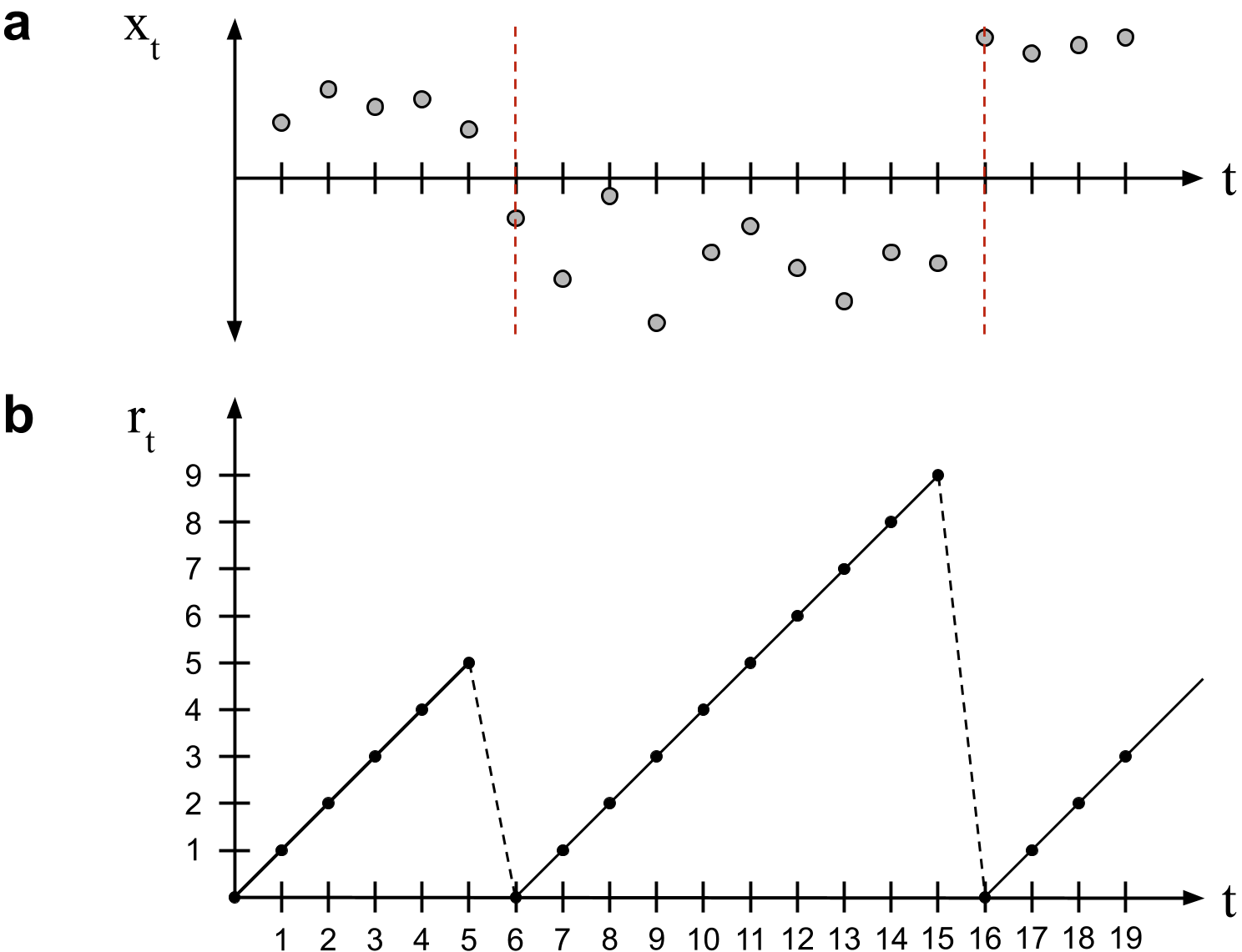
Bayesian online changepoint detection works by modeling the time since the last changepoint, called the run length. The run length at time
In words, the run length only ever increases by one or drops to zero (Figure
Ultimately, we want to infer both the run-length posterior distribution
Recursive RL posterior estimation
In Bayesian inference, if
In words, we weigh our probabilistic model’s predictions by our posterior uncertainty of the model’s parameters. Marginalization means doing this for every possible parameter value. In Bayesian online changepoint detection, this posterior takes a slightly different form. The posterior predictive is the probability of the next data point,
We use
While Adams and MacKay refer to the term analogous to “model” as a “marginal predictive”, I will use underlying probabilistic model (UPM) predictive to clearly disambiguate it from other predictives in this discussion. In the next section, we will see how to efficiently compute this term. For now assume that it is straightforward.
If we can compute the UPM predictive, then we just need to compute the RL posterior, which is proportional to the joint,
We can write this joint recursively as
The first two steps are just marginalization and the chain rule. However, the third step is trickier because it only holds if our modeling assumptions are made. Both of these equations
fall out of our modeling assumptions. Summarizing and annotating the derivation, we have
We now have a recursive algorithm for computing the RL posterior. The algorithm is recursive because after we compute the joint distribution
As an aside, when I first read the paper, Equation
It is useful to think about this recursive algorithm visually. Borrowing language from the paper, we can visualize the message-passing algorithm as living on a trellis (Figure
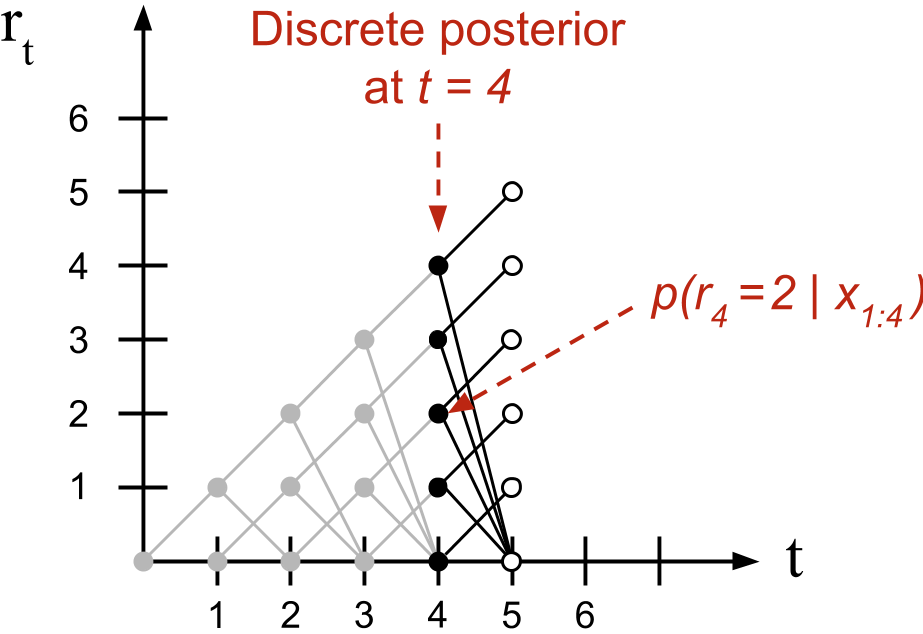
This observation has an important algorithmic consequence. When we compute what Adams and MacKay call the growth probabilities or the probability that the run-length increases, the summation in Equation
In summary, provided we can compute the UPM predictive and the changepoint prior in Equation
Underlying probabilistic model
Computing the UPM predictive leverages conjugacy and the exponential family. In principle, one could abbreviate this section as most of it is not methodologically novel to the paper. However, when I first read the paper, computing the UPM predictive was not obvious to me, and I will go into detail to explain it.
We assume our model is from an exponential family (EF) member with parameters
We know the EF model in Equation
Posterior predictive for conjugate models
Before discussing the exponential family, let’s review the prior predictive for any conjugate model. Let
Since our prior on
for some different hyperparameters
Thus, the posterior predictive is the same as the prior predictive but with hyperparameter
Posterior predictive for exponential family models
Now let’s discuss the prior predictive for the exponential family. Recall that the general form for any member of the exponential family is
where
where
Since the first
Note that this is the same exponential family form as the prior, with parameters:
In other words, we have an efficient way to compute the updated hyperparameters
This [UPM predictive] distribution, while generally not itself an exponential-family distribution, is usually a simple function of the sufficient statistics.
Importantly, these sufficient statistics are additive and can therefore be computed sequentially.
Message-passing parameters
The upshot of the previous subsection is that rather than computing the UPM predictive by computing the EF posterior and integrating out the parameters, we just need to keep track of the exponential family parameters by time
While Adams and MacKay do not describe it this way in the paper, I find it useful to imagine the parameter updates as another message-passing algorithm living on a trellis of possible run lengths, similar to Figure
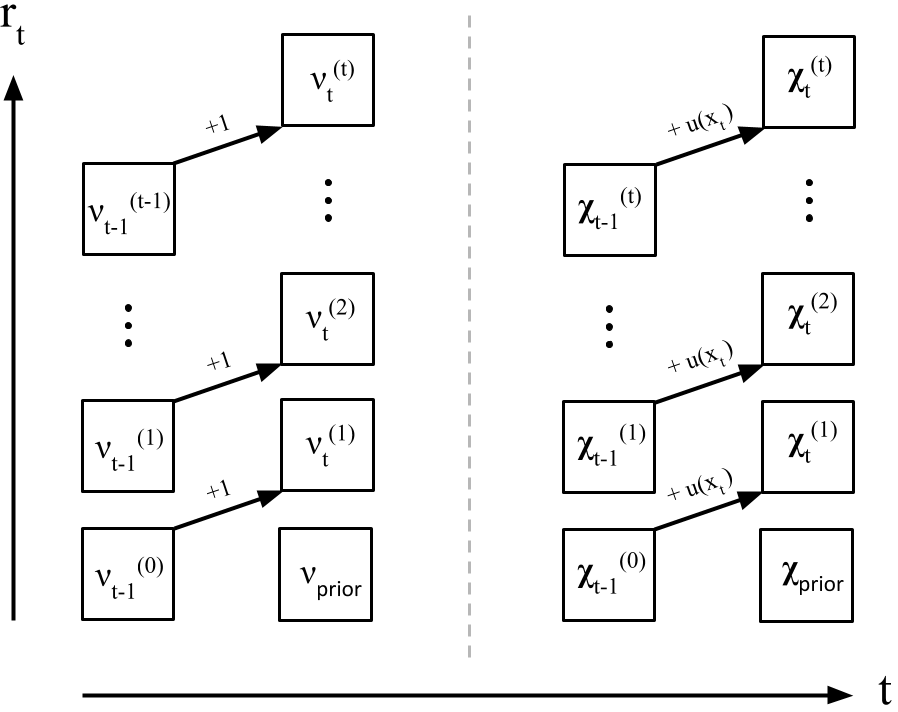
At each time point
Changepoint prior
The changepoint prior allows us to encode our knowledge about our data’s changepoints into the model. Let
Then hazard function
The hazard function quantifies the answer to the question: “Provided a changepoint has not occurred by run length
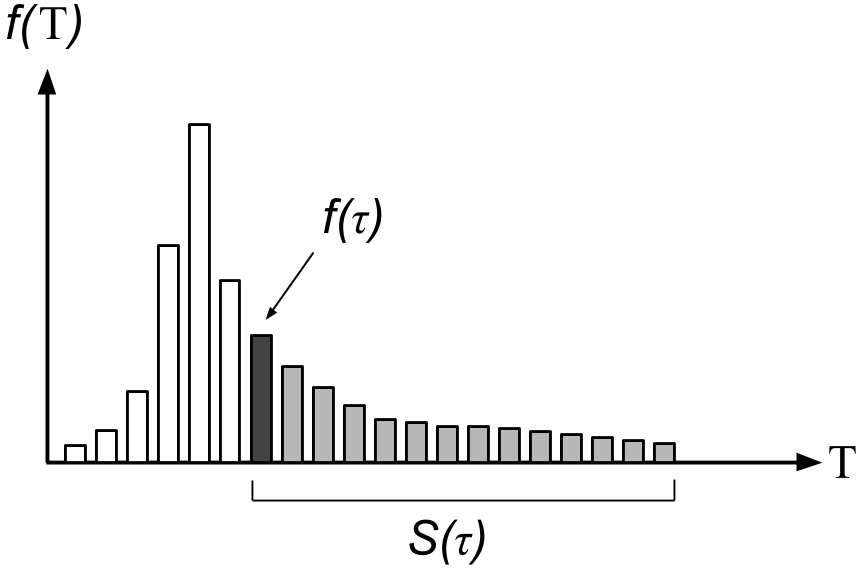
Our modeling assumption is that our changepoint prior is
For Equation
If
Initial conditions
Earlier, we punted on discussing the initial conditions of our recursive algorithm,
We now have the notation to address this question. We have two scenarios. The first scenario is that a changepoint occurred just before the first data point is observed or
The second scenario is that the first changepoint is in the future but we have access to some recent data. The example Adams gives is that of climate change. We have access to historic and current climate data and hypothesize that a changepoint will occur in the future. In this case, the prior over the initial run length is the normalized survival function
where
Sequential inference algorithm
We are now prepared to understand Bayesian online changepoint detection in algorithmic detail. This algorithm estimates the RL posterior distribution and performs prediction at each time point
-
Set priors and initial conditions.
-
Observe new datum
-
Compute UPM predictive probabilities. This calculation is for each possible run length value
At time
-
Compute growth probabilities. The growth probabilities are the probabilities
Note that there is no sum over
-
Compute changepoint probability. The changepoint probability is the probability that the run length drops to
In this case we have a sum over
-
Compute the evidence. This is just the normalizer in Equation
-
Compute the RL posterior. Equation
-
Update sufficient statistics. Equation
-
Perform Prediction. Equation
-
Set
A complete example
Now let’s work through a complete example and implementation of the algorithm. Consider the sequence of
where
See my post on Bayesian Inference for the Gaussian or (Murphy, 2007) for a complete derivation. To make the algebra easier, assume that
In changepoint detection, the number of samples
In both instances, the parameter update is a simple function of the previous parameters and the next data point.
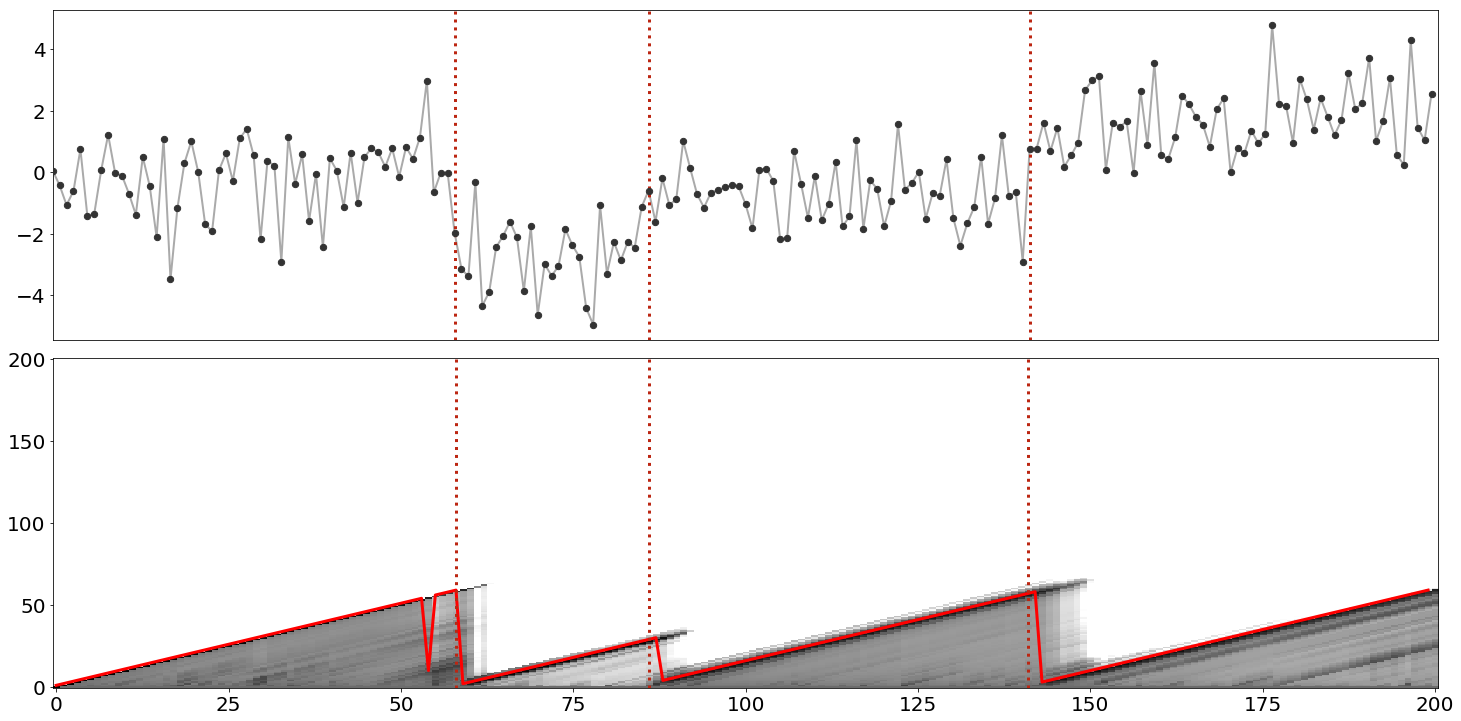
To make things easy, let’s assume a memoryless hazard function,
Now we are ready for code. While we have leveraged a lot of conceptual machinery, the code is strikingly simple:
import numpy as np
from scipy.stats import norm
R = np.zeros((T+1, T+1))
R[0, 0] = 1
max_R = np.empty(T+1)
max_R[0] = 1
H = 1/60
mu_params = np.array([mu0])
lamb_params = np.array([lamb0])
rl_pred = lambda x, mu, lamb: norm.pdf(x, mu, 1/lamb + 1)
for t in range(1, T+1):
x = data[t-1]
pis = np.array([rl_pred(x, mu_params[i], lamb_params[i]) for i in range(t)])
R[t, 1:t+1] = R[t-1, :t] * pis * (1-H)
R[t, 0] = sum(R[t-1, :t] * pis * H)
R[t, :] /= sum(R[t, :])
max_R[t] = np.argmax(R[t, :])
offsets = np.arange(1, t+1)
mu_params = np.append([mu0], (mu_params * offsets + x) / (offsets + 1))
lamb_params = np.append([lamb0], lamb_params + 1)
Note that the above code is a didactic snippet, i.e. you cannot paste this into a file and run it. For a complete example, see my GitHub. We can visualize the results of this algorithm by plotting both the RL posterior and the max posterior value (Figure
Finally, note that Bayesian online changepoint detection is a modular algorithm because both computing the UPM predictive and updating the parameters could be methods on a distribution class that keeps track of the state of its own parameters. Adams notes this in the paper by saying that the framework delineates “between the implementation of the changepoint algorithm and the implementation of the model.”
Conclusions
Bayesian online changepoint detection is a modular Bayesian framework for online estimation of changepoints. It models changes in the generative parameters of data by estimating the posterior over the run length, and it leverages conjugate-exponential models to achieve modularity and efficient parameter estimation. The method is Bayesian in that the changepoint prior allows us to encode knowledge about the world and it models uncertainty about
This paper is from 2007, and I am not up-to-date on the literature on extending this work. However, I would guess that key areas for future work would be addressing the memory usage, which grows quadratically with
Acknowledgements
I thank Diana Cai for giving me an introductory overview of this model and providing working code and Ryan Adams for answering questions about the paper.
- Adams, R. P., & MacKay, D. J. C. (2007). Bayesian online changepoint detection. ArXiv Preprint ArXiv:0710.3742.
- Fearnhead, P., & Liu, Z. (2007). On-line inference for multiple changepoint problems. Journal of the Royal Statistical Society: Series B (Statistical Methodology), 69(4), 589–605.
- Barry, D., & Hartigan, J. A. (1992). Product partition models for change point problems. The Annals of Statistics, 260–279.
- Bishop, C. M. (2006). Pattern Recognition and Machine Learning.
- Murphy, K. P. (2012). Machine learning: a probabilistic perspective. MIT press.
- Forbes, C., Evans, M., Hastings, N., & Peacock, B. (2011). Statistical distributions. John Wiley & Sons.
- Murphy, K. P. (2007). Conjugate Bayesian analysis of the Gaussian distribution. Def, 1(2\sigma2), 16.